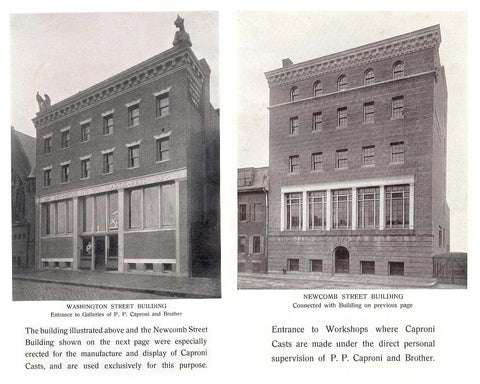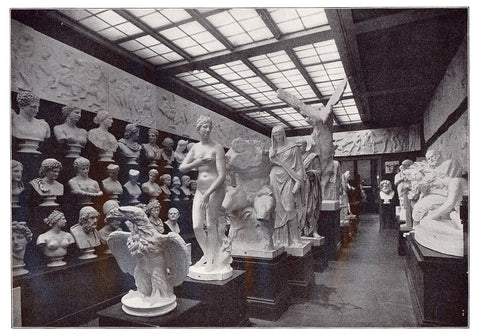History
"The quality of a plaster cast reproduction is of the greatest importance. In an original art work of merit there is a subtleness of treatment, a certain feeling, which if lost in reproducing, places the reproduction outside of what can be classed as a work of art.” ~ P.P. Caproni and Brother, 1902, 1909, and 1911 catalogs
"The quality of a reproduction is of the greatest importance. In an original work of merit there is a subtleness of treatment - a certain feeling which, if captured in reproduction, places the finished piece within the realm of art itself." ~ Lino Giust, 1976 Giust Gallery catalog
Our Story: The Beginning
Plaster casts of sculpture and architectural ornament for study and decoration were at the height of their desirability in 19th century America and Europe. The core collection of pieces we produce was first made and offered by Francis Chickey Company in Boston in 1835. The company was later renamed Chickey and Garey, and finally purchased by Paul Garey who renamed it Paul A. Garey & Company circa 1860. Garey's company received recognition in an 1874 publication entitled Cast Catalogue of Antique Sculpture by William Brigham where it was listed as one of the sixteen master casters in the world and the only one in the United States. Garey’s services were used frequently by sculptor Daniel Chester French who created the Lincoln Memorial in Washington, D.C. In 1892, Garey’s apprentice, Pietro Paulo Caproni, and his brother, Emilio Caproni, purchased the company. The P.P. Caproni and Brother gallery and studio were housed in two buildings connected to one another at the corner of Washington and Newcomb Streets in Boston. The brothers first constructed a building at 8-12 Newcomb Street and then purchased and renovated 1914-1920 Washington Street.

Washington Street and Newcomb Street buildings
The Tradition Continued Under the Caproni Brothers
The two Italian brothers who formed P.P. Caproni and Brother wanted to carry on the tradition of bringing sculpture from around the world to the homes and schools of the American public. Italian master craftsman Pietro Caproni practiced the art of creating quality reproductions. He traveled to Europe multiple times to make molds directly from masterpieces in museums such as the Louvre, the National Museum in Athens, the Vatican, the Uffizi Gallery, and the British Museum. Considered one of the greatest craftsmen of his time, Pietro was one of the last to be allowed the freedom to cast directly from museum objects. He also purchased official plaster casts from European museums’ plaster studios to be used as models. The collection grew to over 4,000 pieces by 1911. The company made the casts available to museums, schools, and private connoisseurs through illustrated catalogs that included such extraordinary pieces as the full-size Winged Victory of Samothrace and Michelangelo's head of David.
“Our casts are from imported models, made directly from the originals, which is the secret of their excellence, apart from the perfection of workmanship in reproduction.” ~ P.P. Caproni and Brother, 1902 and 1911 catalogs
Pietro’s second wife, Gertrude, who had been his assistant prior, evolved into a major player in the company. She managed sales, marketing, including editing the catalogs, and making connections with arts and academic leaders.
An eventual decrease in the popularity of both Classical and Renaissance sculpture prompted the Caproni brothers to add more pieces for artist’s study and some contemporary sculpture to their offerings. They created more life-casts of hands and feet, for example, and casts of ornament, architecture, and casts depicting leaves, around 1911. Although they had always provided a small number of contemporary sculpture, the brothers began working directly with local sculptors, like Cyrus Dallin and Daniel Chester French, to reproduce their work starting in 1913. The collaborations made the sculptors’ work widely and readily available and provided supplemental income for both parties. Thanks to the company’s genius in advertising, its fervent acquisition of new pieces, and the high quality of its casts, P.P. Caproni and Brother became the leading art gallery of its kind in the world.
“For more than thirty years, our Mr. P. P. Caproni has made frequent visits to the principal museums of Europe in order to obtain models made directly from the originals of the most important masterpieces of sculpture.” ~ P.P. Caproni and Brother, 1922 catalog

The Second Room of Antique Sculpture
The Era of Lino Giust
After Pietro Caproni’s death in 1928, the company experienced a decline in business due to a succession of owners and decreases in the appeal of plaster casts and both Classical and Renaissance sculpture. Except for the introduction of a few contemporary pieces, the collection as a whole largely remained as the Capronis had left it.
Thankfully, in the 1960s the company was given new life by a passionate Italian craftsman, Lino Giust. He had been riding the (now defunct) elevated train one day when his curiosity was piqued. He looked down into the display windows of the Washington Street building and saw several beautiful statues standing amidst a sea of plaster fragments. He connected with the owner of the building and learned the story of P.P. Caproni and Brother. Lino purchased 1920 Washington Street with a friend and for several years he cleaned the building and separated the salvageable casts and molds from the ruins. He restored casts as necessary and also learned the crafts of mold-making and casting and became an expert. He rebuilt the collection through such means as auctions and donations of Caproni casts. In 1971, Lino bought the building outright and, in the mid-1970s, he reopened the company as The Giust Gallery. Lino Giust, in essence, returned the company to its former glory.
For a time in the late 1970s and early 1980s when Lino had grown the collection to about 100 pieces, he rented and opened an art gallery as another showroom on high-end Newbury Street in Boston. He continued displaying his casts at Washington Street as well.

A room at the Giust Gallery on Newbury Street
We Remain True to the Tradition
Around the time he opened The Giust Gallery, Lino met sculptor Robert Shure, who felt the same attraction to the plaster cast company as had Lino. As Lino prepared for retirement, Robert Shure and his wife, Kathleen Shure, acquired the company from him in 1992. They later moved the gallery from Boston to nearby Woburn, Massachusetts where it remains today. Robert, in addition to being a renowned sculptor, is also a plaster cast and bronze specialist and a restoration expert who was the perfect fit to lead a new era of the Caproni legacy. Since they embarked on this journey, Robert and Kathleen have been recovering more original Caproni casts and greatly enlarging the collection to the excitement of their employees and followers. At the start of 2019, the Shures changed the company name from The Giust Gallery to the Caproni Collection. The change re-embraces the name that fully encompasses what the company is — a historical collection originating from the work of P.P. Caproni and Brother — while still honoring the legacy of all its predecessors. The casts could not have survived without all of the hands that came into contact with the collection since Pietro and Emilio Caproni.

Identification of Caproni Casts
On antique casts, there is a metal hallmark on or near the bottom or on the reverse of the piece. Antique Caproni casts have one of several versions of metal hallmarks with the company’s information. These small pieces of metal were inserted into the wet plaster during casting (see example below). Starting in the 1960s when the name changed to the Giust Gallery, the company began using a stamp that was pushed into the wet plaster to create incised text (see photo below). We continued to use the Giust Gallery stamp until 2020, soon after we changed our name to the Caproni Collection. The Capronis through to the Shures identify their casts in these ways to signal the pieces’ provenance and quality.

Hallmark dating from c. 1922 to 1960

Hallmark stamp dating from the 1960s to December 2020

Want to learn more?
- For further reading on our history, philosophy, and news, check out our about page, blog and newsletter. The newsletter also features special promotions.
- View or download our historic catalogs and read the blog post exploring their creation.
- You can learn about the process of creating a sculptural reproduction.
- Follow us for news, inspiration, and photos on Facebook, Instagram, Twitter, and Pinterest.

